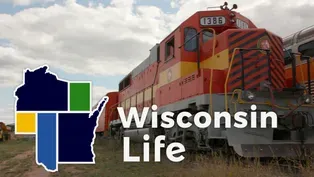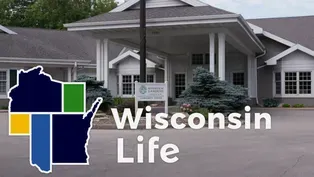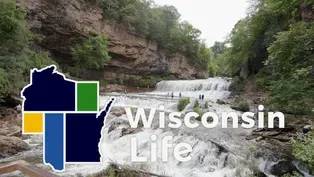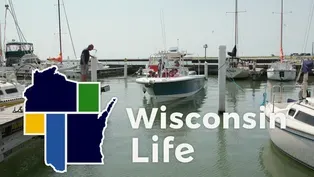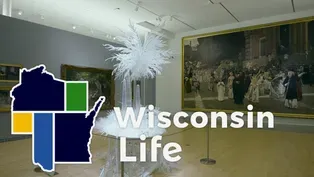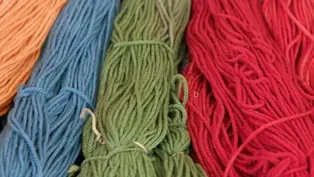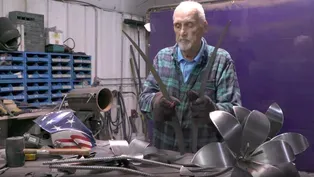
Retzer Nature Center in Waukesha
Season 10 Episode 7 | 26m 48sVideo has Closed Captions
Angela visits the wild side of Waukesha at the Retzer Nature Center and planetarium.
Discover the wild side of Waukesha at the Retzer Nature Center, as we explore the county park’s diverse ecosystems, interactive exhibits and the state-of-the-art planetarium. Then we meet hiker and social media influencer Dineo Dowd as she takes her passion abroad and a self-described curmudgeon shares his love for creating garden art.
Problems with Closed Captions? Closed Captioning Feedback
Problems with Closed Captions? Closed Captioning Feedback
Wisconsin Life is a local public television program presented by PBS Wisconsin
Funding for Wisconsin Life is provided by the Wooden Nickel Fund, Mary and Lowell Peterson, A.C.V. and Mary Elston Family, Obrodovich Family Foundation, Stanley J. Cottrill Fund, Alliant Energy, UW...

Retzer Nature Center in Waukesha
Season 10 Episode 7 | 26m 48sVideo has Closed Captions
Discover the wild side of Waukesha at the Retzer Nature Center, as we explore the county park’s diverse ecosystems, interactive exhibits and the state-of-the-art planetarium. Then we meet hiker and social media influencer Dineo Dowd as she takes her passion abroad and a self-described curmudgeon shares his love for creating garden art.
Problems with Closed Captions? Closed Captioning Feedback
How to Watch Wisconsin Life
Wisconsin Life is available to stream on pbs.org and the free PBS App, available on iPhone, Apple TV, Android TV, Android smartphones, Amazon Fire TV, Amazon Fire Tablet, Roku, Samsung Smart TV, and Vizio.
Providing Support for PBS.org
Learn Moreabout PBS online sponsorshipMore from This Collection
Blackhawk Ski Club in Middleton
Video has Closed Captions
We explore the competitive side of winter sports with the Blackhawk Ski Club in Middleton. (26m 48s)
Holi Festival of Colors in Wausau
Video has Closed Captions
We celebrate the Holi Festival of Colors at the Monk Botanical Gardens in Wausau. (26m 49s)
Wisconsin Great Northern Railroad in Trego
Video has Closed Captions
All aboard the Wisconsin Great Northern Railroad for a historic ride in the Northwoods. (26m 48s)
Video has Closed Captions
We tour Riverview Gardens in Appleton, a non-profit offering job training and employment. (26m 48s)
Willow River State Park in Hudson
Video has Closed Captions
Explore Willow River State Park’s stunning waterfall, serene lake and endless trails. (26m 48s)
Sailing Education Association of Sheboygan
Video has Closed Captions
We learn about adaptive sailing with SEAS, the Sailing Education Association of Sheboygan. (26m 48s)
Museum of Wisconsin Art in West Bend
Video has Closed Captions
Celebrate artists in our state at MOWA, Museum of Wisconsin Art in West Bend. (26m 49s)
Providing Support for PBS.org
Learn Moreabout PBS online sponsorship- The following program is a PBS Wisconsin original production.
- Angela Fitzgerald: Coming up on Wisconsin Life: a hiker on a journey from Wisconsin to Mount Kilimanjaro, an activist planting memorials that bloom, a botanical dyer creating rich textiles.
And a jack of all trades turned garden artist.
That's all ahead on Wisconsin Life!
[uplifting guitars, strings, piano, and drums] - Announcer: Funding for Wisconsin Life is provided by Lowell and Mary Peterson, Alliant Energy, donors to the Focus Fund for Wisconsin Programs, and Friends of PBS Wisconsin.
- Hello, I'm your host, Angela Fitzgerald.
We're set to explore another natural beauty in our state, Retzer Nature Center.
Whether rain or shine, we're delving into the wild side of Waukesha with over 450 acres of diverse ecosystems outdoors, and hands-on exhibits, and a state-of-the-art planetarium indoors.
Retzer is located on the western border of the city with views for miles.
A variety of trails allows hikers to follow the beautiful boardwalk, peruse the restored prairies, [inquisitive piano and gentle brass] and weave through diverse wildlife habitats.
In all seasons, the Discovery Trail provides an accessible path under tall trees with engaging play areas.
Indoors, the Nature Center's interactive exhibits are a fun way to learn about biology, wildlife, and sustainability.
Visitors will also find the planetarium, run in partnership with the Waukesha School District.
Programming that brings the sky to your eye with state-of-the-art equipment and views that are out of this world.
Whether inside, outside, or up in the sky, Retzer is a majestic place to discover the treasures found in nature.
[shimmery music] Now, we trail a hiker in Madison, sharing her love for the outdoors in Wisconsin and abroad.
♪ ♪ ♪ ♪ A day spent outside is a good day for Dini Dowd.
- Dineo Dowd: It's good for your health.
It's good for your brain.
You know, that's how I exercise.
[laughs] Getting outside is very important.
- Dini is a social media influencer and, in her words, a stay-outside mom.
- I believe that people will stick with someone who's authentic.
You know, I don't polish anything.
Whenever I go to social media, I share my experiences.
- Dini loves hiking, camping, and staying active.
But it wasn't always this way.
Dini grew up in South Africa under apartheid-era policies.
- Dineo Dowd: My background growing up in South Africa, it was different as a black person.
We were not allowed to go to national parks or resorts, anything like that.
- Dini didn't truly find her path until she moved to Utah as an adult.
- Dineo Dowd: I think my love for the outdoors and hiking actually started in Utah.
I felt like I was free, like there was just something telling me that this is your chance.
- Eventually, her family relocated here to Wisconsin, a place full of outdoor opportunities.
- So, where are we going?
We're going up here by the... - Armani: Ha!
[laughs rambunctiously] - Today, her adventures are a family affair.
- Whoo!
Armani, look here.
- She travels the state with her husband and their daughter.
- There you go.
We get outside the January to December.
I mean, I don't know, I...
I never thought I would say, "I love winter."
[laughs warmly] - She shares their trips on social media, helping other families plan their own expeditions.
- Dineo Dowd: So, I'm able to share my experiences and kind of give them resources like, "Oh, if you're a new parent and you're looking into, "you know, hiking or camping, "this is where you should go.
This is where you should start."
- The goal is to use her platform to encourage everyone to get outside.
- Like, I get people who message me, like, people of color are moving to Wisconsin, and they will reach out to me and be like, "Hey, we are moving to Wisconsin.
Do you know any groups in this area?"
And I'll even say, "I'll go hiking with you, if you want.
Let's meet out and go hiking!"
- This passion for hiking led her down the trail to another creative idea.
- Ooh, I love books.
I love reading books, and when I was a child, my dad used to buy newspapers for me.
So, I would read newspapers because we couldn't get books from the library.
[Dineo chuckles] I don't know what I'm going to do with you.
- Dini had a hard time finding nature stories to share with her daughter.
So she created her own.
She became a children's book author.
- I said, "Hey, you see, if I am hiking, I am kayaking, you can do this, you know," and I'm trying to show these kids from different cultures and background that the outdoors is for everybody.
- Dini also does this by organizing a range of group activities.
From Wisconsin day hikes to her most daring adventure... - Leader: ♪ Kil-i-man-jaro ♪ - Group: ♪ Kil-i-man-jaro ♪ - Taking a group of women across the world to the summit of Mount Kilimanjaro.
- The good part of the story: they're all moms.
Some of these women, they have never even had a passport before.
[playing wind instrument and cheering] This is the people that I want to be around with.
People who are not scared to take chances and people who can push themselves and, you know, do the things that you don't think your body can do.
- As someone who once wasn't allowed to enjoy the outdoors, Dini is determined to keep trekking toward her dreams.
- I am reborn.
You know, it's like I have another chance in life to do all these things that I didn't get to do.
This place is full of berries, Armani.
Look over there, over there.
- Wherever she goes, this stay-outside mom is helping others who might need a little push to put on their hiking boots.
- If you have a chance to do something, get outside and do it.
♪ ♪ [shimmery music] - We now go to Milwaukee to meet a community activist planting gardens to inspire change.
♪ ♪ ♪ ♪ This is the sound of peace... [resonating high frequencies tone] the sound of healing... [pleasant, resounding vibrations] ...and the sound of wellness.
[bowl hums] - Camille Mays: It helps to relax you.
It's a calming thing, just like listening to water.
- It's also a calm and peaceful afternoon in this northside Milwaukee neighborhood.
- We can walk through the neighborhood today.
A neighbor will wave.
I love my neighbors.
- But Camille Mays will also tell you Sherman Park needs more love.
- Within the last week, we had gunshots.
They were, like, literally on our block.
And I think it's traumatizing.
It's real triggering.
It's scary when you hear 'em so close.
[police sirens] I can't even look at the news.
It was just story after story after story, and really, it's a city-wide problem.
You drive to a neighborhood, and you see memorials all over the place.
Who wants to invest in the neighborhood?
[dog barking] - Those memorials planted an idea for change.
- I started it in 2015.
[police sirens] It was around the time that the homicides had shot up.
- To counter bullets with blossoms.
- I wanted to bring life to our community.
Hope... a little bit 'cause we are hopeless.
- In what she calls Peace Garden Project Milwaukee.
- It was thought to offer flowers and to plant them at the site of a memorial, and that's just a kind gesture I wanted to do for the families.
- Turning temporary memorials into permanent gardens.
- Oh, it's so beautiful.
This was one of my first peace gardens.
No farewell words were spoken; No time to say goodbye; You were gone before we knew it, and only God knows why.
Mm.
That is sad.
That is sad.
- The Peace Garden Project made Camille a well-known community activist.
In 2017, shots rang out just a few blocks from Camille's home.
- As you can see, some perennials here, here, here.
This is one near and dear to my heart.
- Sixteen-year-old Emani Robinson, a neighborhood teen caught in the crossfire.
- Even the people who did not know Emani, we all felt the pain of a child being killed in the community.
At the wrong place, at the wrong time.
Just being a kid at the store one summer day.
It's unfortunate.
And it's been so many more since him.
That's what's sad.
- At that time, Camille said, her activism was a fight to keep the violence from touching her family.
- You see it happening all around you.
I would always tell the mothers, "I don't understand," and "I'm sorry that this happened, and I hope I don't ever understand."
- Prayers and Peace Gardens couldn't keep the repercussions of gun violence from Camille's front door.
- I always would be worried about my son, so I will always call them to see if they were okay.
But he didn't answer the phone.
I remember it was like seven-something in the morning, and somebody was at our door.
And it was the police.
And I know when the police come to your house, it's not good.
It's almost like mentally, I feel like if I didn't let them in the house, like, I could stop whatever they were gonna say or whatever had happened.
- Once again, Camille buried her pain in plants.
This time in her own front yard.
- It's like a healing ritual, in a sense.
- A memorial garden for her 21-year-old son, Darnell.
- We call him "Booka."
He was killed by some of his friends.
The truth of the matter is he knew them from elementary school, and they murdered him.
Everybody always says, "What's gonna make it stop?"
I don't know!
But I know the city need a lot of love.
- Gardens instead of guns.
Flowers instead of fear.
Camille is determined to sow seeds of hope.
- A while back, when everything happened with me, it was very hard for me to continue doing peace gardens.
It just triggers me because it reminds me why I started to do it, and it hurts that it still happened to me.
- She believes something good will grow from this tragedy.
- People are like, "How could something positive happen out of that?"
I just transmute my anger and pain into the healing work that I do.
I put it into my bowls.
I put it into talking to people about the gun violence.
- Today, Camille uses her singing bowls to bring comfort and peace to others facing trauma and distress.
- As I've been through my own trauma now with gun violence, I understand the healing part a little bit more.
[bowl resonates soothing tone] When the bowls had the effect that they did on me, which at first wasn't good, I cried.
I said, "This not what it said it was going to do for me.
Why am I crying like this?"
But that was the release; that was all of that trauma, that pain, that tension, just all of that sadness in me that I had been holding inside.
Because that was my experience, I wanted to share that with other people.
- She dreams of getting a bus to travel and offer sounds that soothe the soul.
Camille's saving grace is finding power in her purpose.
- I just hope that my story inspires people.
That's what motivates me.
I'm not the only one, but this is my story.
I just don't want to be just another person.
I wanted to leave my mark in the world.
And for it to mean something; that's all.
[shimmery music] - I'm at Retzer Nature Center in Waukesha, sharing its bounty of educational activities, from blazing trails to stargazing here in the planetarium.
[children yelling playfully] Park supervisor Janet Barthel knows all there is to uncover here.
- Janet Barthel: Well, I love Retzer Nature Center because, geographically, it's right in the middle of Waukesha County.
So, I feel like it's just a great representative of what Waukesha County has to offer.
But it's a beautiful chunk of land, 488 acres, that is prairie restoration, woodland areas, pine plantations.
It's a glacial drumlin is right in the middle of the property, and so, waterways on either side.
But as far as families coming, it's a great place to go see a planetarium show or go play on our Discovery Trail and the educational components that are interactive outside, or hit the many trails that we have, as well.
But we're definitely a hub for school groups coming and doing their field trips here.
Like, we're the field trip spot, so we're really glad to be an environmental education hub in Waukesha County.
[effervescent, twinkling piano] - An educational hub taking us to galaxies far, far away.
Lisa Swaney runs the programming.
- Lisa Swaney: So, we are a school district-owned planetarium, part of the Waukesha School District, and we are housed in this beautiful nature center.
So, we have this unique partnership with the Waukesha County Parks.
We really are this area for astronomy education for all.
If you wanted to come, you could come every month and see a different show, and a lot of the different topics are just general astronomy.
We have "CAPCOM GO!
The Apollo Story."
So, we have a historic look at the space race.
We have "Forward to the Moon."
Just a wide variety of opportunities where you can get all kinds of different learning taking place here.
- With each visit, a chance to understand the awe-inspiring universe around us.
- Lisa Swaney: They just love it.
I mean, I think that they keep coming back.
after they've come once, and they realize what a great venue we are, and opportunities to do so many things.
I mean, whether it's on the side of Retzer or here right on the planetarium, you kind of get the of both worlds.
- It is the best of both worlds, with interactive ways to explore and learn.
- 'Cause we'll quite often tag that you get a planetarium show along with a natural history-type program.
But then, when we added the recycling exhibit, as well, and that, a group can really get a pretty comprehensive understanding of how things work in our ecosystems and how they can make a difference and do things to help it.
We want kids to get in there, get dirty, get their hands, touch, smell, all of it.
So, I mean, our goal is if we're making amazing little stewards that are going to grow up and be adults and make a difference for our planet, then we know we've done our job.
[birds chirping] [shimmery music] - Next, we head to Lodi to meet a botanical dyer using nature to create a wide variety of colorful fibers.
♪ ♪ [warm, carefree acoustic guitar] In Lodi, on a busy corner in an old car dealership building... - Kipp Inglis: I do like being down here in Lodi.
I like the interaction.
- ...is an artist who makes her craft from natural dyes.
- Kipp Inglis: I'm just a color freak.
I like color.
Most chemical dyes are made with metal salts, and some of those are pretty caustic.
The natural dyeing that I do, and I prefer to call it 'botanical dyeing,' is pretty much with everyday chemicals that we use in the kitchen.
- For Kipp Inglis, it took a while to learn the joys of natural pigments.
- I was a acid dyer for years, using dyes that use vinegar, basically.
And about eight years ago, was introduced to dyes made from plants that we could get this range of colors from something that's so readily available.
Just fascinated by the process.
So, decided to relearn dying from that point of view.
I'm always looking for a wider range of colors that I can get from the plants, and the challenge of doing it-- we have to do this all on natural fibers.
It's easy to do on wool, little harder on silk.
I've just started using hemp, and I love it.
Very difficult on cotton, and I love trying to do it on cotton.
I'm just the facilitator.
Mother Nature is in charge of all of this.
I just kind of bring it to the light.
- Kipp highlights Mother Nature's ability to provide a variety of rich dyes.
- I use madder from madder root.
I use cochineal from cochineal bugs.
I use weld, which is a fast-growing weed that's easy to grow for a fantastic yellow.
And then, I use indigo.
And indigo has a whole different process than all the other dyes.
Right now, indigo is kind of at the top of the list for everybody.
It's very popular, and I love using it.
And combining those dyes will give you a very, very wide range of colors.
Reusing and sustainability are driving factors in the process.
I guess I'd like us to understand that we should stop buying new wardrobes every two years and start reusing what we've got.
My Boro process over here, the stitching is old, old, old technique from Japan, where they would keep garments going for generations.
It was much easier just to patch and keep going.
- Learning and passing on that knowledge pushes Kipp to continue experimenting and teaching.
- Because I'm a process person, that's mostly what I teach is process.
There is some, I guess, if you want to call it recipe work that I teach them.
But to see the excitement on their faces when they can make something work, and then, beyond that, to see what they do with it afterwards.
I don't consider myself a very good artist, but a lot of my students have become very, very good artists, and that, to me, is-- just keeps me going.
♪ ♪ [shimmery music] - For our final story, we meet a jack of all trades in Columbus, who went from renovating antique carriages to creating garden art.
♪ ♪ ♪ ♪ [sanding sound] For many years, Gene Frey has been a jack of all trades.
- Gene Frey: I like to keep busy.
- Along with his sons, Gene also had a popcorn wagon.
- Gene Frey: We had a lot of fun with it.
That was a 1930 Model A.
We sold it, and I always kind of missed the popcorn wagon, so I started building one.
My son and I started building carriages years ago.
This has got the skis, so you can take the wheels off and put skis on it.
- In addition to building modern buggies, they restore elaborate antique carriages.
- We did more buggy restorations than we did on sleighs; beautiful sleighs.
- And from buggies, sleighs, and popcorn trucks, Jean discovered art.
- I've always liked metal and woodworking.
I just kind of went together.
These are what I make cattails with.
I twist irons like this, and then, I bend them and bring them up around the cattails.
- Gene carved out a niche with his garden art and a spot to work in his son's carriage shop.
- My son said, "You might as well have a space."
It's not real big, but it's big enough for what I do.
- Every one of Gene's metal sculptures is made by hand.
[clanging] - And then, we just go all the way around like that.
That's how we make these flowers at the end.
They look like this.
I do more of the birds, ducks, skis, pheasants.
It's pretty much metal and welding and whatever I can come up with.
Some of it sells, some of it doesn't.
- He does all of this without any formal art training.
- I don't know about art training.
I just kind of picked it up; just self-taught.
- The industrial art Gene creates is built to last.
- Gene Frey: I got some pheasants on my lawn that's been there for 17, 18 years, and some flowers and stuff.
They're all rusty and everything, but they last for a long time.
I like to have a reason to get up in the morning and do something.
So, I get out and go down to the shop and try to put something together and dream of something to make.
At my age, I only work about three hours when I go down, and then I go home.
- Gene's casual schedule also allows him to be on call at the art gallery and carriage shop in downtown Columbus.
- Gene Frey: My son owns the building.
We thought it'd be good for the downtown and be something different to have.
[bass, piano, and jazz guitar swing music] A lot of people say, "You do a beautiful work."
I get a lot of good comments.
I've never had any bad ones.
- And the name for this art space... - My son came up with that name.
Curmudgeons & Company.
I can't even pronounce it, to be honest.
[laughing] He kind of thinks we both are, but I don't.
It's just me.
[metal clanging, sparks spraying] When you get my age, you gotta have something to do, and I don't like watching the idiot box.
I'll be honest with you.
[chuckles] Just a lot of enjoyment.
♪ ♪ [shimmery music] - My time trailblazing has come to an end.
We've shared stories from across our state while exploring the diverse ecosystems here at Retzer Nature Center.
To find more, visit us at WisconsinLife.org and connect with us on our social media channels or by emailing Stories@WisconsinLife.org.
I'm your host, Angela Fitzgerald, and this is our Wisconsin Life.
Bye!
[mellow, soothing music] [birdsong] [snowshoes crunching] - Funding for Wisconsin Life is provided by Lowell and Mary Peterson, Alliant Energy, donors to the Focus Fund for Wisconsin Programs, and Friends of PBS Wisconsin.
Video has Closed Captions
A botanical dyer shares her process creating a wide range of colors while teaching others. (4m 22s)
Video has Closed Captions
Despite no formal art training, 80-plus-year-old metal artist is garnering attention. (3m 56s)
Video has Closed Captions
Dini Dowd loves nature and uses her platform to encourage everyone to get outdoors. (4m 37s)
Video has Closed Captions
Camille Mays is trying to make a difference in Milwaukee by fighting bullets with blooms. (6m 56s)
Providing Support for PBS.org
Learn Moreabout PBS online sponsorshipSupport for PBS provided by:
Wisconsin Life is a local public television program presented by PBS Wisconsin
Funding for Wisconsin Life is provided by the Wooden Nickel Fund, Mary and Lowell Peterson, A.C.V. and Mary Elston Family, Obrodovich Family Foundation, Stanley J. Cottrill Fund, Alliant Energy, UW...


